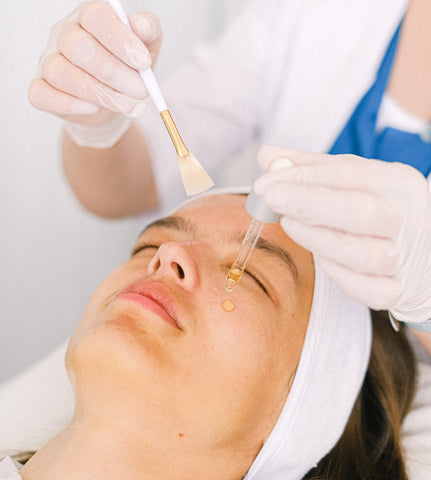A facial peel (chemical peel) is a cosmetic procedure using safe chemicals to gently remove the outer skin layers. Facial peels exfoliate the skin, promoting the generation of new skin cells – making skin look healthier and younger. They commonly address skin concerns such as acne, wrinkles and rosacea.
How do facial peels work?
Facial peels use chemical solutions to gently remove the outer layers of dead skin. The chemicals exfoliate the skin, unclogging pores and correcting skin discolouration. The skin typically has a pH of around 5.5. Acids in facial peels lower the skin’s pH. This separates the dead skin layer from the healthy skin layer beneath. Exfoliation from the peel removes the dead skin cells. The chemicals stimulate the skin to continue peeling naturally for a period, creating smoother skin and a brighter complexion.
Do facial peels work?
Facial peels work to alleviate various skin concerns. They are a common cosmetic procedure that many people benefit from. Skin professionals like dermatologists often utilise peels for treatment. However, results vary depending on your skin and the peel type. Speak with your technician to establish expectations for the procedure.
How often should you do a facial peel?
How often you should do a facial peel depends on the type of peel. Follow-ups are usually necessary. Light facial peels can typically be repeated every one to four weeks. Medium facial peels can require six to twelve months between treatments. Deep facial peels are not recommended for repeated use. High-concentration deep peels can be limited to once in a lifetime.
What types of facial peels are there?
There are three main types of facial peels: light (or superficial), medium and deep. They are classified based on how deeply they affect the skin layers. Within these three main types are subcategories based on the ingredients used.
Light Facial Peels
Light facial peels use the mildest ingredients for skin exfoliation. Light facial peels only affect the epidermis, the most outer skin layer. They provide subtle skin improvements. The three most common light facial peels are alpha hydroxy, beta hydroxy, and Jessner's peels. Alpha hydroxy is a class of acidic compounds. Alpha hydroxy peels are the most gentle type of light facial peel. They treat minor acne, dry skin, fine lines and uneven skin tone. The most common acid for alpha hydroxy peels is glycolic acid, which comes from sugar cane. It is effective at stimulating collagen production and exfoliating the skin. Beta hydroxy is a class of lipid-based acid compounds. Beta hydroxy peels penetrate deeper than alpha hydroxy peels. This is because their lipid base allows them to attach to the skin's natural oils. They follow the oils into deeper skin layers. They are used to treat congested skin and blemishes. Salicylic acid is the most common acid for beta hydroxy peels. It is effective at providing anti-inflammation and clearing out pores. Jessner’s peels are most commonly made of lactic acid, salicylic acid and resorcinol. Their penetration level and benefits vary based on their concentration and combination of acids. They can contain mandelic acid to combat inflammation, higher levels of lactic acid for skin hydration or phytic acid for sensitive skin. If they have a higher concentration, Jessner peels can be used as medium facial peels.
Medium Facial Peels
Medium facial peels penetrate the epidermis and a deeper skin layer into the dermis. They provide significant skin improvements. Trichloroacetic acid (TCA) is the most common base for a medium facial peel. Its penetration depth varies depending on its concentration. TCA mainly treats acne scars, deep wrinkles and pigment irregularities.
Deep Facial Peels
Deep facial peels penetrate further into the layers of the dermis than the other types of peels. They provide the most dramatic skin improvements. Phenol is the most common type of deep facial peel. Its base is carbolic acid, which is paired with salicylic acid or resorcinol. Phenol peels are highly concentrated. A health professional must administer them. Phenol peels are used for deep wrinkles and scars.

How do you prepare for a facial peel?
You prepare for a facial peel by consulting with a Mosman Spa specialist who assesses and determines your optimal treatment. Preparation varies depending on the type of peel. A specialist may need access to your medical history. This includes medical conditions, past cosmetic procedures and current medications you take. They examine your skin to pinpoint target areas. This lets them decide which peel is suited to your skin type. They will talk to you about the procedure’s possible benefits and risks.
Your skincare professional may recommend other steps, such as using a tretinoin cream in the leadup to your treatment. This helps the skin heal. You may need to avoid certain cosmetic or hair removal treatments the week before your peel. Facial masks and facial scrubs can lead to over-exfoliation from the peel. This results in skin irritation. Hair removal makes your skin more sensitive. This can cause increased irritation from the peel. Avoiding overexposure to the sun before your treatment is important.
What to expect during a facial peel
What to expect from a facial peel will depend on the type of peel. All facial peel treatments start by cleansing the skin. For a light facial peel, the chosen solution is applied to the skin. There may be a stinging feeling from the solution. A wash or neutralising solution is used to clean the treated skin. For a medium facial peel, the chemical solution is applied to the skin. A cool compress will be applied to the treated skin for soothing. The skin may feel a stinging or burning sensation for 20 minutes.
How long does it take to recover from a facial peel?
The time it takes to recover from a facial peel depends on the type of peel. Light facial peels typically heal within a week. Medium facial peels can take two weeks to recover from. On rare occasions, redness can last for a few months. Your personal circumstances influence the healing processes.
What do you do after a facial peel?
What to do after a facial peel depends on the type of peel. After any facial peel, avoiding exposure to the sun and applying sunscreen is important. For a light facial peel, you may experience dryness, redness and irritation in your skin. You can use certain ointments to soothe the skin. For a medium facial peel, you will feel redness, swelling and stinging. Certain ointments can be used for soothing and preventing dryness. Ice packs and over-the-counter pain relief medication like ibuprofen can also help. Your aesthetician will provide recovery instructions. These will include which products to use and how often to wash or moisturise the face. Ice packs can be helpful for soothing.
Is a facial peel right for me?
A facial peel may be right for you, depending on your skin type and the peel type. Facial peels are very individualised. You must work with your skincare professional to find the right facial peel for you. Some conditions will prevent you from safely undergoing a facial peel. This includes if you are nursing or pregnant, if you are sunburnt or if you have areas of broken skin. Deep facial peels should only be done for extreme skin concerns. Facial peels generally benefit people with lighter skin tones.
Chat with one of Mosman Spa’s specialists to discuss your skin goals and find out what treatment is best suited to you. Want to try an at-home facial peel? Shop our facial peel products by clicking here.
